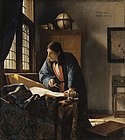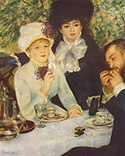Städelovo muzeum
| Städelovo muzeum | |
|---|---|
 | |
| Údaje o muzeu | |
| Stát | |
| Adresa | Frankfurt nad Mohanem, 605 96, Německo |
| Založeno | 1816 |
| Zeměpisné souřadnice | 50°6′10″ s. š., 8°40′26″ v. d. |
| Webové stránky | |
| Některá data mohou pocházet z datové položky. | |
Städelovo muzeum (česká výslovnost [štédlovo], německy Städel Museum, plným jménem Städelsche Kunstinstitut und Städtische Galerie, Städelovský umělecký institut a městská galerie) ve Frankfurtu nad Mohanem je jedno z nejvýznamnějších německých muzeí. Spravuje přes 4000 maleb od středověku po současnost a další umělecké předměty, fotografie a rozsáhlou knihovnu. Založení muzea umožnil svým odkazem Johann Friedrich Städel roku 1815. Ke sbírkám patří i několik světoznámých obrazů, například Botticelliho Portrét Simonetty Vespuciové a Tischbeinův Goethe v Kampánii, nejslavnější zpodobení básníkovo.
Galerie
- Barnaba da Modena: Madona s dítětem, 1367
- Hornorýnský mistr: Rajská zahrádka, 1410/1420
- Bartolomeo Veneto: Ideální portrét ženy, asi 1520/1525
- © José Luiz Bernardes Ribeiro, CC BY-SA 4.0Sandro Botticelli: Simonetta Vespuciová jako nymfa, asi 1480
- Giovanni Bellini: Madona s dítětem, Janem Křtitelem a sv. Alžbětou, poč. 16. stol.
- © José Luiz Bernardes Ribeiro, CC BY-SA 4.0Jan van Eyck: Madona z Luccy, asi 1437/1438
- Hieronymus Bosch: Ecce Homo, asi 1480/1490
- Mistr z Flémalle: Sv. Veronika s rouškou, asi 1430
- Hans Holbein mladší: Simon George of Cornwall, asi 1535/1540
- Lucas Cranach starší: Venuše, 1532
- Lucas Cranach starší: střední deska Torgauského oltáře, 1509
- Giovanni Antonio Canal: Benátky z Riva degli Schiavoni, asi 1730/1740
- Giovanni Battista Tiepolo: Svatí ochránci rodu Crottů, asi 1750
- Nicolas Poussin: Pyramus a Thisbé v bouřlivé krajině, 1651
- Antoine Watteau: Odplutí na Kythéru, asi 1710
- Jan Vermeer: Geograf, 1669
- Rembrandt van Rijn: Oslepení Samsona, 1636
- Jan van Goyen: Haarlemské moře, 1656
- Frans Hals: Muž (z dvojportrétu), 1638
- Adam Elsheimer: střední deska Frankfurtského oltáře Ukřižování, 1605/1609
- Georg Flegel: Zátiší s chlebem a cukrovím, asi 1637
- Jacob Philipp Hackert: Pohled na Basiliku sv. Petra, 1777
- Johann Heinrich Wilhelm Tischbein: Goethe v Kampánii, 1787
- Eugène Delacroix: Fantasia arabe, 1833
- Gustave Courbet: Vlna, 1869/1870
- Gustave Courbet: Frankfurt nad Mohanem se Starým mostem od Sachsenhausenu, 1858
- Claude Monet: Snídaně
- Édouard Manet: Kriket, 1873
- Edgar Degas: Členové orchestru, 1870/1871
- Pierre-Auguste Renoir: Po snídani, 1879
- Vincent van Gogh: Portrét Dr. Gacheta
- Carl Spitzweg: Vzpomínka při vůni růže, 1850
- Max Liebermann: Dvůr amsterodamského sirotčince, 1881/1882
- Paul Klimsch: Pěstitel papoušků, 1901
- Franz Marc: Pes ležící ve sněhu, asi 1910/1911
- Ernst Ludwig Kirchner: Varieté (pár anglických tanečníků), 1912/1913
- August Macke: Dvě dívky, 1913
Externí odkazy
 Obrázky, zvuky či videa k tématu Städelovo muzeum na Wikimedia Commons
Obrázky, zvuky či videa k tématu Städelovo muzeum na Wikimedia Commons - Oficiální stránky
Média použitá na této stránce
The Wave
Varieté; English Dancers
Two Girls
In the central panel the Glorification of the cross by the Saints, the prophets and the angels is shown. On the right, are the 4 the patriarchs including Moses, Abraham and King David. Jonas is sitting on the fish, looking up towards the cross, and St Catherine and Mary Magdalene are in a sisterly embrace. In the foreground is a disputation between St Sebastian and the 4 Fathers of the Church, Pope Gregory, St Jerome, St Ambrose and St Augustine, with the first Christian martyrs St Stephen and St Laurence.
Autor: Simsalabimbam, Licence: CC BY-SA 3.0
Das Städel in Frankfurt am Main.
لوحة غوتة في ريف روما بريشة الألماني فيلهيلم تيشباين - 1787
Städel - Frankfurt am Main - Germany
Portrét Dr. Gachet
This painting is the first version of this motif
© José Luiz Bernardes Ribeiro, CC BY-SA 4.0
Städel - Frankfurt am Main - Germany
The side and central panels describe a a great hall with blue grey walls and three-colored tiles.
central panel: depicts Joseph, who seems asleep, the Virgin, dressed in blue with yellow lining, Anna and the Christ Child on her knee, who is stretching out his hand towards an apple given to him by Virgin Mary. Anna's three husbands following the Golden Legend are shown in the background in the matroneum: on the left Joachim, who is attracted by the holy women in front of him and whose relation is also shown by the corresponding blue and yellow color of his dress, Cleophas (with the physiognomy and chain of Emperor Maximilian I and Salomas (eventually with the physiognomy of Sixtus Oelhafen von Schöllenbach, secretary of Friedrich III., Maximilian I. and Karl V. Charles V.]]., who are talking to each other.
There is an architectural structure by a great stone bench in the foreground of the central panel with two marble columns on the sides, over which is strectched a cloth of gold. On the right column is a tablet with date and signature. The parapet of the matroneum is decorated by a sculptured frieze with dancing putti holding six escutcheons with the six fields of Electorate of Saxony. In the hall are shown the 17 members of the Holy Kinship. In the central panel are shown two more children of Mary Cleophas and Alpheus, the Apostles Simon, patron saint of weavers, dyers, tanners and saddlers and Jude, who miss ionized and suffered their martyrdom together and therefore are regularly depicted together.
left outer wing: Madonna with Child, right outer wing: Saint Anne
© José Luiz Bernardes Ribeiro, CC BY-SA 4.0
Vier Personen haben sich zum Krocketspiel versammelt: im Vordergrund sitzend der Künstlerkollege Alfred Stevens, im Hintergrund Paul Roudier, ein Freund Manets. Dazwischen sind Alice Lecouvé und Victorine Meurent zu sehen, die den Impressionisten Modell standen. Selten kam Manet der impressionistischen Malweise so nahe wie hier. Die Provokation war geplant: Die vermeintlichen Ehepaare sind die Künstler und ihre Modelle – die bürgerliche Idylle erweist sich als Trugbild.
Orchestra Musicians













































































